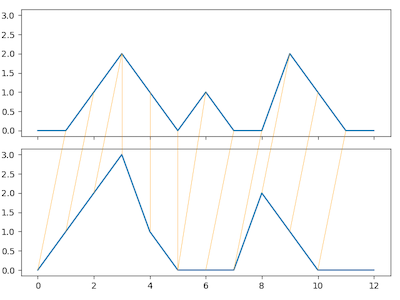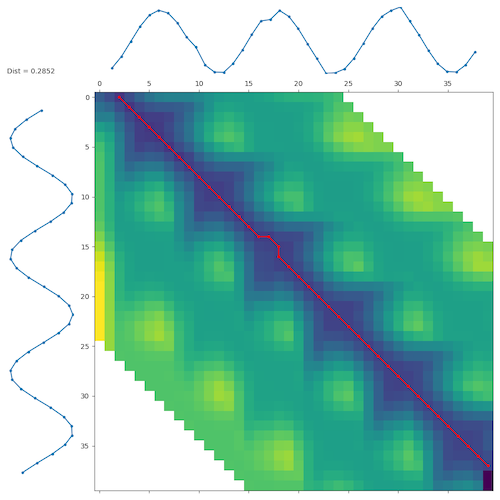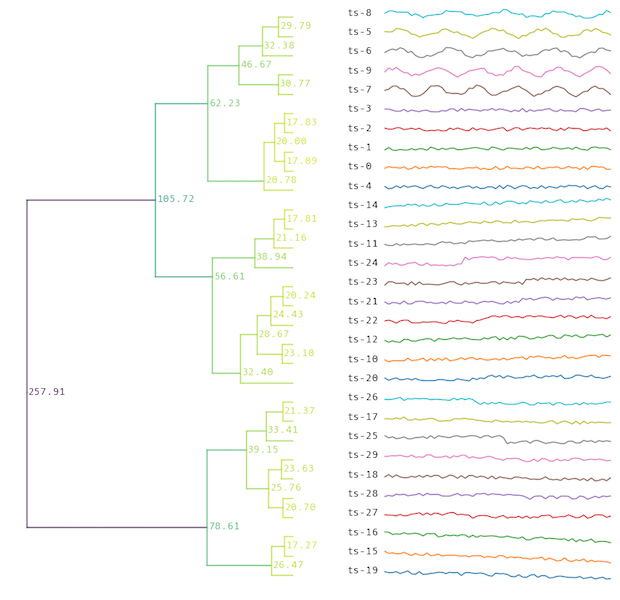Distance measures for time series
Project description
Library for time series distances (e.g. Dynamic Time Warping) used in the DTAI Research Group. The library offers a pure Python implementation and a faster implementation in C.
Documentation: http://dtaidistance.readthedocs.io
Installation
This packages is available on PyPI:
$ pip install dtaidistance
In case the C based version is not available, you might need to run make build or python setup.py build_ext --inplace to compile the included library first.
The source code is available at github.com/wannesm/dtaidistance.
Usage
Dynamic Time Warping (DTW) Distance Measure
from dtaidistance import dtw from dtaidistance import dtw_visualisation as dtwvis import numpy as np s1 = np.array([0., 0, 1, 2, 1, 0, 1, 0, 0, 2, 1, 0, 0]) s2 = np.array([0., 1, 2, 3, 1, 0, 0, 0, 2, 1, 0, 0, 0]) path = dtw.warping_path(s1, s2) dtwvis.plot_warping(s1, s2, path, filename="warp.png")

DTW Example
DTW Distance Measure Between Two Series
Only the distance measure based on two sequences of numbers:
from dtaidistance import dtw s1 = [0, 0, 1, 2, 1, 0, 1, 0, 0] s2 = [0, 1, 2, 0, 0, 0, 0, 0, 0] distance = dtw.distance(s1, s2) print(distance)
The fastest version (30-300 times) uses c directly but requires an array as input (with the double type):
from dtaidistance import dtw
import array
s1 = array.array('d',[0, 0, 1, 2, 1, 0, 1, 0, 0])
s2 = array.array('d',[0, 1, 2, 0, 0, 0, 0, 0, 0])
d = dtw.distance_fast(s1, s2)
Or you can use a numpy array (with dtype double or float):
from dtaidistance import dtw import numpy as np s1 = np.array([0, 0, 1, 2, 1, 0, 1, 0, 0], dtype=np.double) s2 = np.array([0.0, 1, 2, 0, 0, 0, 0, 0, 0]) d = dtw.distance_fast(s1, s2)
Check the __doc__ for information about the available arguments:
print(dtw.distance.__doc__)
A number of options are foreseen to early stop some paths the dynamic programming algorithm is exploring or tune the distance measure computation:
window: Only allow for shifts up to this amount away from the two diagonals.
max_dist: Stop if the returned distance measure will be larger than this value.
max_step: Do not allow steps larger than this value.
max_length_diff: Return infinity if difference in length of two series is larger.
penalty: Penalty to add if compression or expansion is applied (on top of the distance).
psi: Psi relaxation to ignore begin and/or end of sequences (for cylical sequencies) [2].
DTW Distance Measure all warping paths
If, next to the distance, you also want the full matrix to see all possible warping paths:
from dtaidistance import dtw s1 = [0, 0, 1, 2, 1, 0, 1, 0, 0] s2 = [0, 1, 2, 0, 0, 0, 0, 0, 0] distance, paths = dtw.warping_paths(s1, s2) print(distance) print(paths)
The matrix with all warping paths can be visualised as follows:
from dtaidistance import dtw from dtaidistance import dtw_visualisation as dtwvis import numpy as np x = np.arange(0, 20, .5) s1 = np.sin(x) s2 = np.sin(x - 1) d, paths = dtw.warping_paths(s1, s2, window=25, psi=2) best_path = dtw.best_path(paths) dtwvis.plot_warpingpaths(s1, s2, paths, best_path)

DTW Example
Notice the psi parameter that relaxes the matching at the beginning and end. In this example this results in a perfect match even though the sine waves are slightly shifted.
DTW Distance Measures Between Set of Series
To compute the DTW distance measures between all sequences in a list of sequences, use the method dtw.distance_matrix. You can set variables to use more or less c code (use_c and use_nogil) and parallel or serial execution (parallel).
The distance_matrix method expects a list of lists/arrays:
from dtaidistance import dtw
import numpy as np
series = [
np.array([0, 0, 1, 2, 1, 0, 1, 0, 0], dtype=np.double),
np.array([0.0, 1, 2, 0, 0, 0, 0, 0, 0, 0, 0]),
np.array([0.0, 0, 1, 2, 1, 0, 0, 0])]
ds = dtw.distance_matrix_fast(s)
or a matrix (in case all series have the same length):
from dtaidistance import dtw
import numpy as np
series = np.matrix([
[0.0, 0, 1, 2, 1, 0, 1, 0, 0],
[0.0, 1, 2, 0, 0, 0, 0, 0, 0],
[0.0, 0, 1, 2, 1, 0, 0, 0, 0]])
ds = dtw.distance_matrix_fast(s)
DTW Distance Measures Between Set of Series, limited to block
You can instruct the computation to only fill part of the distance measures matrix. For example to distribute the computations over multiple nodes, or to only compare source series to target series.
from dtaidistance import dtw
import numpy as np
series = np.matrix([
[0., 0, 1, 2, 1, 0, 1, 0, 0],
[0., 1, 2, 0, 0, 0, 0, 0, 0],
[1., 2, 0, 0, 0, 0, 0, 1, 1],
[0., 0, 1, 2, 1, 0, 1, 0, 0],
[0., 1, 2, 0, 0, 0, 0, 0, 0],
[1., 2, 0, 0, 0, 0, 0, 1, 1]])
ds = dtw.distance_matrix_fast(s, block=((1, 4), (3, 5)))
The output in this case will be:
# 0 1 2 3 4 5 [[ inf inf inf inf inf inf] # 0 [ inf inf inf 1.4142 0.0000 inf] # 1 [ inf inf inf 2.2360 1.7320 inf] # 2 [ inf inf inf inf 1.4142 inf] # 3 [ inf inf inf inf inf inf] # 4 [ inf inf inf inf inf inf]] # 5
Clustering
A distance matrix can be used for time series clustering. You can use existing methods such as scipy.cluster.hierarchy.linkage or one of two included clustering methods (the latter is a wrapper for the SciPy linkage method).
from dtaidistance import clustering
# Custom Hierarchical clustering
model1 = clustering.Hierarchical(dtw.distance_matrix_fast, {})
# Augment Hierarchical object to keep track of the full tree
model2 = clustering.HierarchicalTree(model1)
# SciPy linkage clustering
model3 = clustering.LinkageTree(dtw.distance_matrix_fast, {})
cluster_idx = model3.fit(series)
For models that keep track of the full clustering tree (HierarchicalTree or LinkageTree), the tree can be visualised:
model.plot("myplot.png")

Clustering hierarchy
Dependencies
Optional: - Cython - tqdm - matplotlib
Development: - pytest - pytest-benchmark
Contact
References
T. K. Vintsyuk, Speech discrimination by dynamic programming. Kibernetika, 4:81–88, 1968.
H. Sakoe and S. Chiba, Dynamic programming algorithm optimization for spoken word recognition. IEEE Transactions on Acoustics, Speech and Signal Processing, 26(1):43–49, 1978.
C. S. Myers and L. R. Rabiner, A comparative study of several dynamic time-warping algorithms for connected-word recognition. The Bell System Technical Journal, 60(7):1389–1409, Sept 1981.
Mueen, A and Keogh, E, Extracting Optimal Performance from Dynamic Time Warping, Tutorial, KDD 2016
D. F. Silva, G. E. A. P. A. Batista, and E. Keogh. On the effect of endpoints on dynamic time warping, In SIGKDD Workshop on Mining and Learning from Time Series, II. Association for Computing Machinery-ACM, 2016.
C. Yanping, K. Eamonn, H. Bing, B. Nurjahan, B. Anthony, M. Abdullah and B. Gustavo. The UCR Time Series Classification Archive, 2015.
License
DTAI distance code.
Copyright 2016-2018 KU Leuven, DTAI Research Group
Licensed under the Apache License, Version 2.0 (the "License");
you may not use this file except in compliance with the License.
You may obtain a copy of the License at
http://www.apache.org/licenses/LICENSE-2.0
Unless required by applicable law or agreed to in writing, software
distributed under the License is distributed on an "AS IS" BASIS,
WITHOUT WARRANTIES OR CONDITIONS OF ANY KIND, either express or implied.
See the License for the specific language governing permissions and
limitations under the License.
Project details
Release history Release notifications | RSS feed
Download files
Download the file for your platform. If you're not sure which to choose, learn more about installing packages.
Source Distribution
Built Distribution
Hashes for dtaidistance-1.0.1-cp36-cp36m-macosx_10_13_x86_64.whl
| Algorithm | Hash digest | |
|---|---|---|
| SHA256 | 710054966d21b27117b7167aa900a36b5cc9910fcc73bcf0e59bf156d781bfb1 |
|
| MD5 | 27bfa15ef08d86f7ba4fb71133e96d4a |
|
| BLAKE2b-256 | f2e62caba72e4fbc07a774886a3b4794fd3c9c98eafcecdb9dd9253ce52b8b16 |












